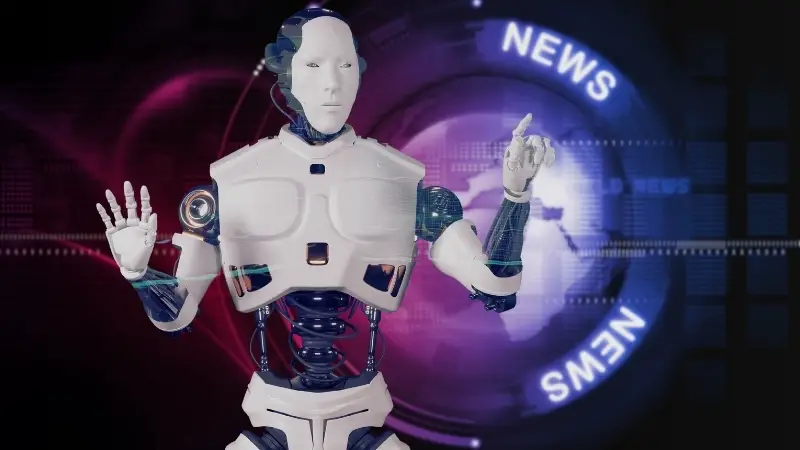You know that feeling when you read a news article and think, “Did a robot write this?” It’s not just your imagination. Artificial intelligence is behind a lot more of what we read than we might expect.
There’s a lot going on when it comes to how news gets written today, and it’s only fair to give you the inside scoop in a fun and approachable way. So, buckle up!
Table of Contents
ToggleKey Points
- Machines are writing a lot of today’s news.
- AI has its fingerprints in many parts of the newsroom.
- AI tools can detect machine-generated text.
- Human writers aren’t going anywhere soon.
- Not all news is made by machines, but AI is getting better.
1. Machines Are Everywhere in Newsrooms

You might not realize it, but machines have quietly become major players in newsrooms around the world. They handle everything from generating financial reports to writing recaps of sports events.
In some places, robots are even suggesting headlines. Whether it’s crunching numbers or putting together a quick summary, machines have the speed and efficiency to get the job done.
But don’t get too worried. As fast as machines are, they still lack that human touch when it comes to opinion pieces or nuanced storytelling. For instance, transferring text to image is quite efficient, but there’s always room for some of the text not to be included.
At the moment, they’re mostly being used for straightforward topics like weather updates or stock market reports. If you’re reading a heartfelt feature, odds are it’s still a human at the keyboard.
2. Can We Tell What’s Written by Machines?
With machines being so sneaky, how do you even know if what you’re reading was written by a person or not? This is where detectors come in handy.
These tools, like the detector de IA by ZeroGPT, can help identify whether a piece of writing was generated by a machine or a person. It’s not foolproof, but it’s a good way to catch some of the more obvious machine-written articles.
As AI gets more advanced, though, these detectors are going to have their work cut out for them. Machines are learning to sound more human all the time. It’s like a game of cat and mouse between AI and the people who try to catch it.
And guess what? The machines are getting faster.
3. AI Is Great for Numbers, Not So Much for Emotions

One thing machines excel at is crunching data. When it comes to writing news articles full of stats or facts, they’re unmatched.
Want a breakdown of a football match with all the key stats? A machine can whip that up in seconds. Want the latest numbers on a company’s quarterly report? Machines have that covered too.
But here’s the catch: they’re terrible at emotion. Machines can’t feel joy, sadness, or frustration. So if you’re reading an article about a personal story, rest assured that it’s still humans writing those. Machines just don’t have the ability to convey genuine emotion the way we do.
4. Will Machines Replace Journalists?
Here’s a big question: are journalists going to be out of jobs soon? The short answer is no, at least not anytime soon. While machines are great for writing news that’s heavy on facts and light on opinion, they’re not so great at in-depth analysis or investigative reporting.
Journalists still have an edge when it comes to creating meaningful stories that connect with readers. Machines can write news, but they can’t interview people, dig through documents, or tell stories with heart. As long as there’s a demand for those things, humans aren’t going anywhere.
5. Machines Save Time, But They’re Not Perfect

They can misinterpret data or make mistakes that a human would catch. Imagine reading a machine-written article about a political scandal, only to realize it got key details wrong because it didn’t understand the context. Frustrating, right?
That’s why even when machines do the writing, humans usually review the articles before publishing them. It’s a collaboration between human editors and their robotic assistants. Machines make the process faster, but humans keep it accurate.
6. The Future of News Is Human-Machine Collaboration
Rather than thinking of machines as replacements, it’s better to see them as tools that can help journalists work faster. By automating routine tasks, journalists can focus on deeper, more interesting stories. It’s like having an assistant who handles the boring stuff so you can focus on the fun part.
In the future, we’ll likely see more collaboration between humans and machines in the newsroom. The goal isn’t to replace people but to give them more time and space to do what they do best: tell stories that matter.
7. How Much News Is Actually Machine-Written?

Okay, so how much of the news is actually being written by machines? It depends on the publication. Some news outlets use machines for as much as 50% of their content, especially when it comes to routine reports like financial updates. Others use AI more sparingly, only for tasks like suggesting headlines or summarizing articles.
Smaller outlets might not use machines much at all, preferring to stick with good old-fashioned human writers. But in large, data-heavy newsrooms, machines are definitely pulling their weight.
8. AI Is Changing News, But Not All Change Is Bad
Change can be scary, especially when machines start doing things we thought only humans could do. But the rise of AI in newsrooms isn’t necessarily a bad thing. Machines can handle the more boring parts of news writing, freeing up journalists to focus on creativity and analysis.
In many ways, machines are making the news industry more efficient. As long as we remember that they’re just tools—and not replacements for human judgment—there’s nothing to fear.
9. What’s Next for AI in News?
Where is AI in the news headed next? Well, expect to see even more advanced machines in the newsroom.
They’ll probably get better at writing more complex articles and may even help out with research for investigative reports. But even as AI continues to evolve, human journalists will still be the ones digging deep, interviewing sources, and bringing us the stories that truly matter.
It’s a bit like a buddy system: the machines handle the heavy lifting, and the humans bring the heart and soul. And who knows?
Maybe one day we’ll look back and laugh at the idea of being worried about machines taking over. They’re just tools, after all, and tools only get better when people know how to use them right.
Final Thoughts
Machines might be behind more of the news we read than we realize, but there’s no need to panic. They’re fast and efficient, but they lack the human touch that makes stories memorable. As AI continues to develop, we’ll likely see more collaboration between humans and machines in the newsroom.
It’s important to stay informed and know when we’re reading something written by a machine or a person. That way, we can appreciate the strengths of both—and enjoy the best of both worlds. So next time you read a news article and wonder, “Who wrote this?” the answer might surprise you. But at least now, you’ll know how to spot it.










